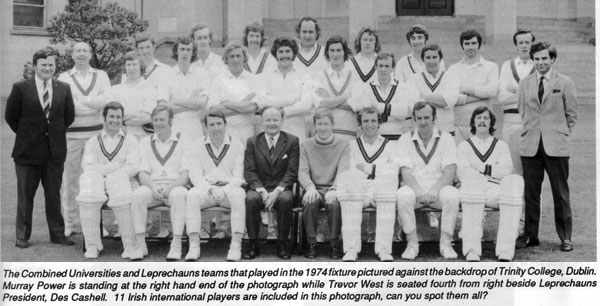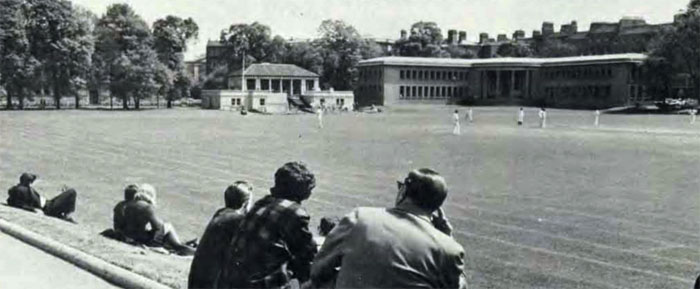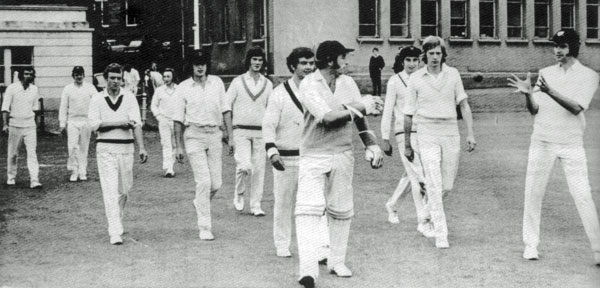MARATHON FINAL DELAYS A HONEYMOON
The man who coined the phrase "glorious uncertainty" to describe cricket must surely have had a university team in mind.

In several respects 1973 has been a typical season, with the Irish university sides making such uncertain progress that all three finished near bottom of their respective leagues. At the same time, they have had their moments of glory, occasionally producing performances of such authority and enthusiasm as to make them seem unbeatable.
Who would have expected that a Combined Universities side without a bowler of regular Guinness Cup experience would skittle a Leprechauns team including eight current internationals for a paltry 66 at College Park?
Who at the beginning of the season would have risked even a 10p bet on the chances of Queen's reaching the NCU Senior Cup final - and giving the mighty Waringstown the toughest run they can remember?
Dublin University had a particularly disappointing season, poor performances in league and cup coupled with defeat by both rival universities presented a disal prospect, although a successful end of term tour to the South of England did much to raise their spirits. To fill the gap left by two such able players as Chris Harte and Michael Halliday was an almost impossible task, and this year's captain Corrie Halliday was regularly let down by his batsmen.
Only John Silverstone was really experienced, and often it was left to the lower batsmen, especially John Shaw, to raise a reasonable score. In the bowling, seamers Shaw and John Frankland did most of the damage. Shaw, in fact, had an outstanding all-round season and was selected by Ulster Town on his return to Belfast.
Queen's, by contrast, had one of their most experienced and best-balanced teams of recent years and for the first three months virtually dominated Ulster cricket. A strong batting line-up was spearheaded by Graham Crothers who, although unable to recapture last year's magnificent form, was still the team's leading batting scorer with more than 400 runs.
His sudden rejection by the Irish selectors can scarcely have been on grounds of ability. Other batsmen to shine were skipper Alan McCully, Brian Hunniford, Philip Marshall, and newcomer Robert Farmer, who announced his arrival by scoring a century in his fourth match.
Five bowlers shared the attack, Bertie McGill was the most successful, taking more than 40 wickets with his medium pace seamers. The spinners, Alan McCully and John Davey, and pacemen Dessie Kane and Ernie Halliday each took more than 25 wickets - a good team effort. Crothers, McCully, McGill, and Kane all represented Ulster Town during the season.
Queen's path to the cup final contained much good cricket; a huge score of 242 to beat Ballymena; a good team effort against Cliftonville; a fighting 7th wicket stand between McCully and McGill to overcome Bangor; and a real thriller of a semi-final when Woodvale were defeated by one wicket with a four off the last ball.
The final itself was a titanic struggle spread over five days because of rain. The University batting failed in the first innings, only Farmer (40) and Kane (33) making significant contributions to the total of 126. The bowlers then struck back, and skipper Deryck Harrison's 69 alone enabled Waringstown to gain a first innings lead of 29. Going in again Queen's did much better. Led by an aggressive48 from Crothers they reached 166 for eight, setting Waringstown 138 to win.
At 29 for two with 25 of their 60 overs gone they were in trouble but Jim Harrison hit a brisk 57 and they won by seven wickets. No one was happier to see the end of the game than Alan McCully - it had delayed his honeymoon! The tension and sustained effort of this match seemed to drain Queen's, for they lost their remaining six league games. From kings to paupers - how often it happens to a student team!
The New University of Ulster, who field a staff-student team had an indifferent season. The highlight of their year was their first ever match with Trinity, an exciting game in Dublin which the visitors won. In the cup they were less fortunate, going down to the eventual champions, Brigade, in a tight first round game.
NUU were captained by seam bowler David Hayes, younger brother of the illustrious Frank. David Eastwood, a staff member, had a good all-round season, while the leading batsmen were Alan Peacock and John Hall.
 View over College Park during the match between Leprechauns and Irish Universities
View over College Park during the match between Leprechauns and Irish Universities
Since 1971 the two Northern universities have been jointly sending a regional team to the British Universities Sports Federation cricket tournament. In 1972 the team had been highly successful, being placed third behind Oxford and Cambridge, and it was the major disappointment of the season when they had to withdraw from this year's tournament because they could not raise a team. With such a small pool of players to select from it is understandable that the effect of holidays, jobs, family commitments and injuries should occasionally so erode the numbers as to make participation impossible.
To guarantee a strong team from this side of the Irish Sea it is necessary to extend the scope of selection, and many favour a system which would enable players from Trinity and other southern universities to be included. For the sake of the future of university cricket in Ireland it is to be hoped that some such formula can be agreed with the Federation.
Thoughts of the Irish universities selecting a joint team bring us to the highlight of our season - the annual fixture between the Combined Universities of Ireland and the Leprechauns. This year's match took place at College Park, Dublin in late July, and once again was an outstanding sporting and social success. The Leprechauns, having been held to a draw last year, fielded a particularly strong side including eight of the Irish party that later went to America.
The Universities were hampered by the unavailability of two of their 1972 stalwarts, John Silverstone and John Davey, bit picked a useful side comprising Graham Crothers (captain), Alan McCully Bertie McGill, Dessie Kane (all Queen's). Corrie Halliday, John Shaw, John Frankland (Dublin University), Alan Peacock, John Hall, David Hayes (NUU) and Jack Short (UCC).
Peacock subsequently withdrew and was replaced by Philip Marshall of Queen's. The Universities, batting first, struggled on a difficult wicket against the accuracy of Dougie Goodwin, Gerry Duffy and Michael Halliday. Only a masterly 51 by Short enabled Crothers to declare at 118 for nine after 76 overs.
 The Irish Universities XI going out to field against the Leprechauns at College Park
The Irish Universities XI going out to field against the Leprechauns at College Park
An astonishing two hours followed during which the talented Leprechauns were routed by excellent medium-fast bowling. Shaw began the slide and at 41 for two McGill was brought on to join him. In quick time the team were back in the pavilion for 66, Shaw finishing with 6 for 17 and McGill three for 17. At the close of the first day the Universities led by 57 with nine second innings wickets in hand.
On the second morning the students struggled again, but once more Jack Short stood firm. The Cork man was 30 not out when the last wicket fell at 82. The Leprechauns were left to score 135 in three and a half hours and this time batted with much more resolution. Hope and Duffy put on 55 for the second wicket before Shaw removed Hope for 17. McGill bowled O'Riordan and Harte in rapid succession and then had Duffy caught for 44, so that at 73 for five with an hour to play the match was wide open again.
Then S.D. Molins came in to play the decisive innings. From the start he attacked the bowling and his 34 included three fours and a six. His bold knock took the Leprechauns to the brink of victory, and they won with three wickets and four overs to spare. McGill finished with four for 36. Another fine match proving that there is no side in Ireland which the Universities cannot meet on equal terms.
On the social side, His Excellency The British Ambassador kindly invited all the players and officials to a cocktail reception at his residence. This proved a most fitting climax, and all present would wish to thank Sir Arthur Galsworthy for his generous hospitality on this memorable occasion.
The Universities have a special role in Irish cricket. Over the years they have been the nurseries where many top players have first shown their true potential. They are now co-operating as never before, but no matter how well they work together they must still rely totally on the rest of the cricket community for their supply of players.
It is vital that the message that student cricketers should play for their university be spread throughout the country. Far too many are still induced not to leave their old clubs, and are thus denied a unique opportunity to improve their cricket in a stimulating environment. Just as a university needs good scholars to keep academic standards high, so a university cricket club needs every good player there to keep its cricketing standard high.
Only by doing that can the universities continue to make their full contribution to Irish cricket.
